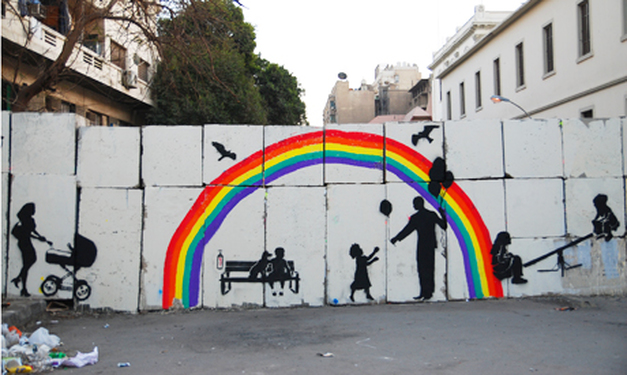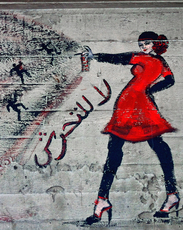|
Street art and graffiti played a large role in political protest during Egypt’s 2011 revolution, as mentioned in one of our previous posts. Many artists used their murals as a platform for social campaigns against the government on topics like women’s rights and freedom of speech. Soraya Morayef, a journalist and photographer in Cairo and the owner of the blog Suzee in the City, told the Smithsonian; “There are so many artists and styles. You can tell when someone has been influenced by Banksy or hip-hop fonts, but there are also a lot of individual styles using Arabic calligraphy and that have been inspired by Egyptian pop culture. There is Alaa Awad, who paints pharaonic temples and murals but with a modern twist to them. Then you have El Zeft and Nazeer, who plan their graffiti like social campaigns, where they pick a strategic location and write about it on social media and make short videos” (Quote taken from here). “Nefertiti’s Daughters,” a 2014 documentary directed by Mark Nickolas and co-directed by Elizabeth Van Meter and Racha Najdi, illustrates the important role Egyptian street artists played during the country’s 2011 revolution in protesting the government. The film features the work and commentary of artists Bahia Shebab, Mira Shihadeh, Salma Samy, Ammar Abo Bakr, Amr Nazeer, Shahira Amin, and Christiane Grube as they use their artwork to illustrate various underlying problems in Egyptian society. You can see a preview of the film from YouTube below (or here). The documentary highlights several important themes evident throughout the revolution, one of these themes being the involvement of women. Many female artists have contributed to the art lining the walls of Cairo since 2011. Many female artists chose to protest during the revolution with a spray can, using graffiti to oppose the government’s mistreatment of Egyptian citizens (and women). Women in Egypt have become increasingly active artists since 2011, providing valuable commentary on the country’s human rights violations. In response to the growing number of female activists, organizations dedicated to documenting their work have grown. Notable groups include Women on Walls and NooNewsa. Personally, I viewed this documentary as having a dominant gendered theme. I think the director’s decision to include female street artists and their work helped show how increasingly active they have become in Egyptian politics. Being denied formal political involvement, these women have turned to other platforms to find their voices and share their concerns. In addition to watching “Nefertiti’s Daughters” through a viewing at my school, I had the opportunity to briefly interview the director of the film, Mark Nickolas, through e-mail. Q: What drew you to the idea of making a documentary about the street artists in Egypt during the revolution? Did you have any previous knowledge or connections to the movement, or was "Nefertiti's Daughters" your starting point? Mark Nickolas: The idea for Nefertiti’s Daughters grew out of watching the 2011 uprisings in the Arab world and how politically-charged graffiti and revolutionary street art played such a prominent role as an act of social resistance. As someone who came to filmmaking after many years in Democratic Party politics, I was fascinated by the revolutionary aspect of this form of expression and how, through the simple act of writing on walls, these artists communicated their society’s hopes, dreams and demands. After watching a 2012 TED talk by Egyptian artist Bahia Shehab (the main subject of the film), I began to understand not only the violence that women in Egypt face on a daily basis, but how courageous women like Bahia tackled these previously taboo social issues through street art. After raising $20,000 on Kickstarter at the beginning of 2014, we spent 11 days in Cairo filming in April 2014. Q: For the most part, the international community was relatively unaware of the work illustrated in the documentary by female street artists you interviewed. What was the international community's reaction to your documentary? MN: I'm not sure I agree with the premise. Q: Have you received any feedback from the Egyptian government after the release of the film? MN: No, and I guess that's a good thing. My fear has always been that these artists put themselves at risk by going so public with their work and thoughts about the revolution and the aftermath. In fact, I shared the rough cut of the film with all the subjects because I was concerned that what they said in April 2014 (when I filmed in Cairo), they might not have said a few months later after General Sisi became President Sisi. But not one of them asked that anything be changed or removed. Q: Do you think the film has had an impact on Egyptian politics (more specifically, the street art movement and political protest)? MN: I don't think it has had any impact. But that's not what I think documentary filmmaking is necessarily about. I think what we do as filmmakers adds an important layer of context and knowledge as we all try to grapple with an increasingly complex world, as well as shine light on issues of importance that the traditional media has overlooked. While I still turn to sources like the New York Times as a staple of gathering information, I also try to watch a lot of documentary and narrative films to add a depth and richness to my understanding of the world. I hope that Nefertiti's Daughters has made a small contribution to that goal. But it's a rare film that has direct impact on events. I greatly enjoyed “Nefertiti’s Daughters,” and suggest it to anyone with an interest in Middle Eastern and Northern African affairs, women’s affairs, Egyptian politics, and/or street art and graffiti. This documentary acts as an extension of Bahia Shebab’s TED talk, incorporating the work and commentary of Bahia and other artists during and after Egypt’s initial revolution. It emphasizes the important sociopolitical role street art and graffiti have in Egypt.
NOTE: The first image was taken from here, and the last three were taken from the film’s website. None of these images are not our own.
0 Comments
Leave a Reply. |
What we're watching. Archives
October 2017
Categories |





 RSS Feed
RSS Feed
